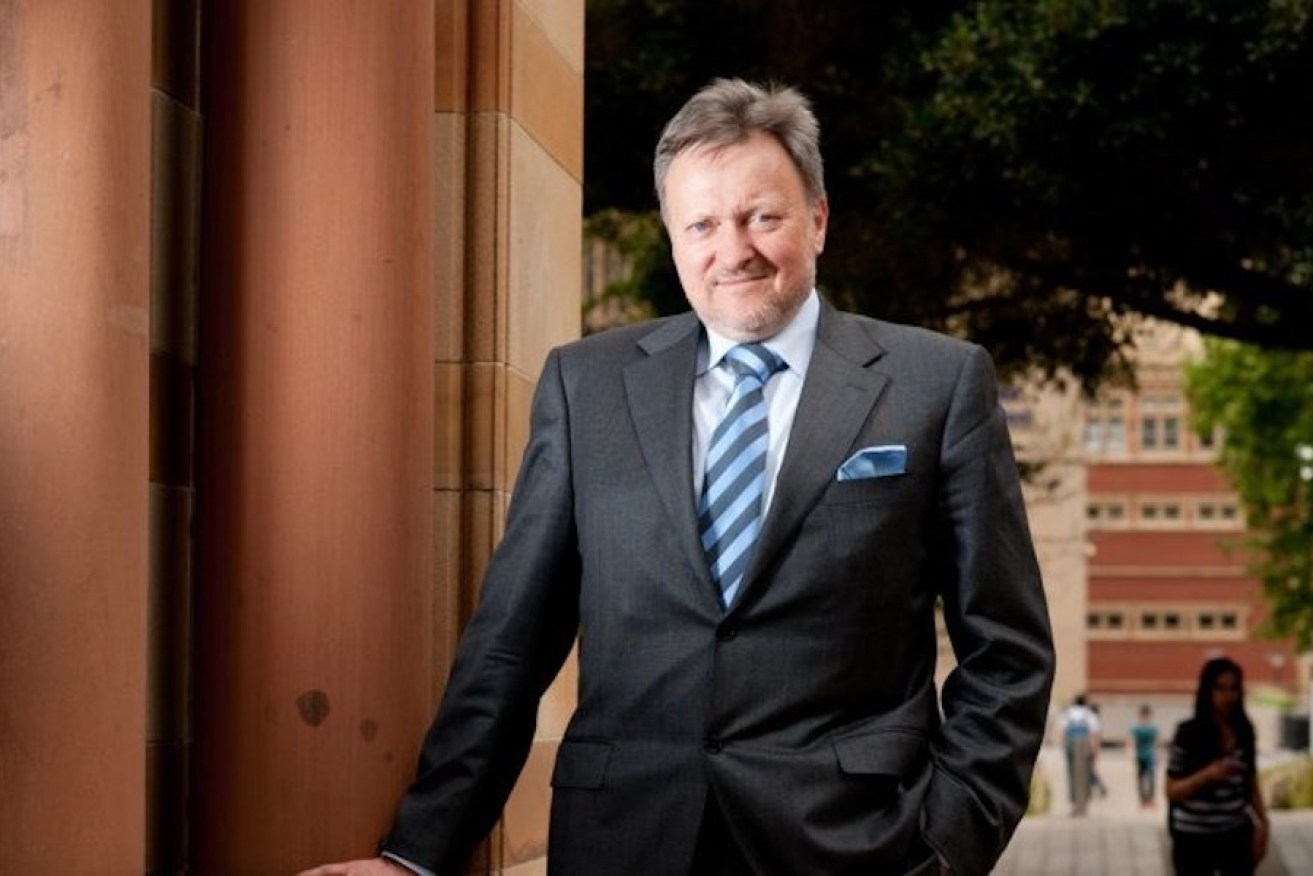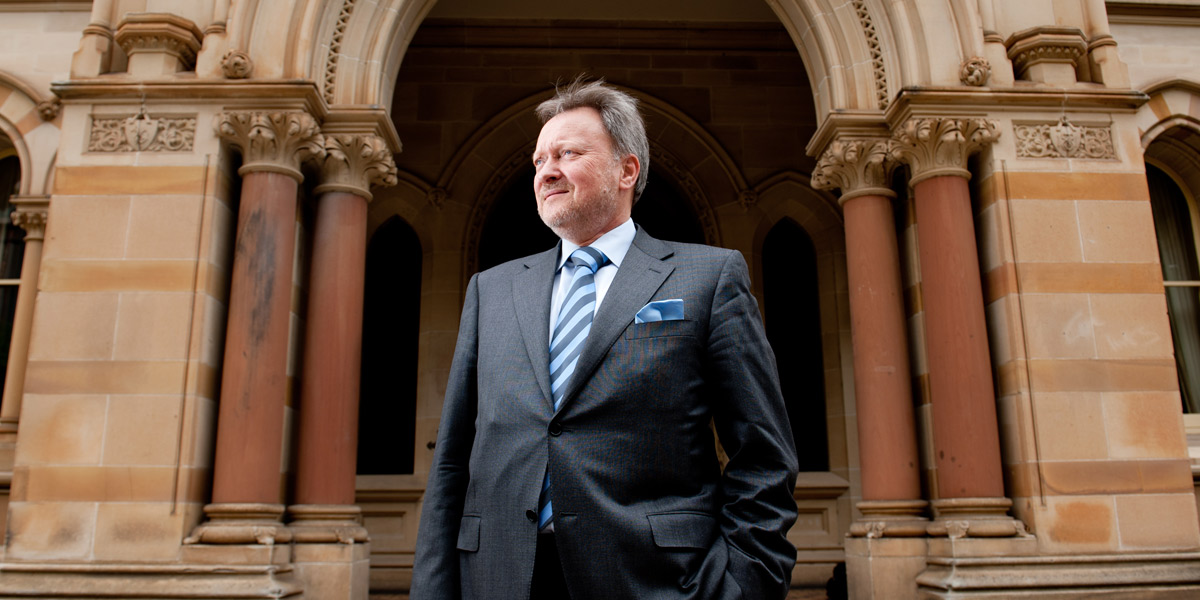Ex vice-chancellor slams rush to uni merger
A former University of Adelaide vice-chancellor says the agreed university merger is a “solution to a problem South Australia doesn’t have” and risks creating a “lumbering dinosaur dependent on an outdated business model”.


Former University of Adelaide vice-chancellor Warren Bebbington. Photo: Nat Rogers/InDaily
Warren Bebbington, University of Adelaide vice-chancellor from 2012 to 2017, gave evidence on Thursday to the parliamentary inquiry into the establishment of Adelaide University.
The inquiry is scrutinising the Malinauskas Government’s push to merge the University of Adelaide and University of South Australia with $444.5m in support.
Bebbington, who opposed a university merger while he was vice-chancellor, used his opening statement on Thursday to say the legislation to create a new university is “very premature” and should be delayed for “at least a year”.
He said this was because the federal government’s review of higher education, the Australian Universities Accord, looms as “the most far-reaching reform of the Australian university system since (former Labor education minister) John Dawkins in 1990”.
“Thirty years ago, no state rushed ahead of John Dawkins to try to anticipate what he was going to do,” Bebbington told the inquiry.
“And I put it to you that no state now should rush ahead of the Accord and its reforms before it is very clear from legislation what’s coming, because I think what’s coming will be quite exciting opportunities.”
The Accord’s final report is not due until December and any legislative reforms stemming from the review will not come before federal parliament until 2024.
In its July interim report, the Accord panel, chaired by another former University of Adelaide vice-chancellor, Mary O’Kane, said Australia’s higher education system “would benefit from having a wider range of complementary institutions differentiated by their unique missions”.
Bebbington argued that most states will use the Accord as an opportunity to add smaller universities and “little study centres” into their higher education mix.
“If South Australia has rushed not to add a university, but subtract one – and indeed to cement into place a Dawkins large one-size-fits-all comprehensive, but then pressing its size to an unknown extreme, an extreme where it will be captive of large classes – it will have the kind of sluggish management response to change that you get in huge organisations and low student satisfaction,” Bebbington said.
“If South Australia does this, it will have missed the opportunity to use its funds to create new, nimble, custom-made colleges and study centres.
“It will have created instead a lumbering dinosaur, dependent on an outdated business model driven by international student fees and which assumes that cross-subsidising research is just going to go on forever.
“South Australia would be locked into launching in 2026 a giant that, by then, will be quite out of step with the changed university environment in Australia.”
The state government and two universities say a new Adelaide University will educate 70,000 students a year – around 13,000 more than they both do currently – and attract an additional 6000 international students.
The Accord’s interim report described the SA university merger as an “interesting opportunity” for reform but also warned that pursuing economies of scale is not “necessarily in line with the needs of students”.

Former University of Adelaide vice-chancellor Warren Bebbington. Photo: Nat Rogers/InDaily (2013)
Bebbington stressed to the committee that he was not opposed to all mergers and highlighted the creation of the University of Manchester in 2004 and California’s higher education master plan reforms in the 1960s as successful examples.
But he said the changes to California’s university system were to deal with a “massively expanding population in California [and] huge numbers of students left behind”.
“South Australia doesn’t have this problem – there’s not massive growth here,” Bebbington said.
“The demographics are quite flat, and demographics can tell us what’s happening 20 years from now.
“The school leaver figures have been steady for years; so, this is the solution to a problem South Australia doesn’t have.”
Bebbington, now at the University of Melbourne as an honorary professorial fellow, also criticised the vision statement developed for the merger by the universities of Adelaide and South Australia.
Released in March, the six-page document outlines that the new Adelaide University would have three “strategic pillars”: teaching and learning, research, and engagement.
The document states Adelaide University would also be ranked in the top one per cent of universities globally and would work to be recognised among the world’s top 100 universities on an “ongoing and sustainable basis”.
Bebbington said: “One of my problems with the vision is there’s not a single specific example of how this would benefit any field of teaching or research – not one.”
He later added: “If you were to ask me what (the merger) is going to do and what impact it would have, I would say I can’t tell.
“Because the vision statement, it’s not a picture of a bold, fresh new university; it’s a collection of generalisations and peppered with repeated references to size and equity matters.
“I just can’t see what the picture is.”
Bebbington also criticised the transition plan developed by the universities.
The plan proposes that the University of Adelaide and UniSA vice-chancellors will jointly lead development of the new institution and be co-vice-chancellors of Adelaide University for its first year.
He said that was “very different” to how the University of Manchester was created in 2004 whereby the vice-chancellors of the two merging institutions retired and allowed an outsider to come in “with no baggage” and advocate a long-term vision.
“The foundation vision statement for Manchester in 2004 was very sharp, very well focused,” Bebbington said.
“The founding vice-chancellor (Australian academic Alan Gilbert, also a former University of Melbourne vice-chancellor) had a very clear idea – nine principles of what he was going to do.
“And he arrived eight months before the opening date, so he had eight months to advocate his 10-year Manchester 2015 vision.
“In fact, what we’ve got here (in South Australia), as I understand it from the Transition Plan, is very different from that.
“Instead of appointing a founding vice-chancellor and asking him for the vision, there’s going to be rotating vice-chancellor for three years, including a year beyond the opening of the university.
“So, I think the vision statement to me reads not like a vision, it reads like a very carefully worded compromise between two competitors.”
The merger inquiry resumes on Monday, with University of Adelaide vice-chancellor Peter Høj and his UniSA counterpart David Lloyd due to appear before the committee next week.




